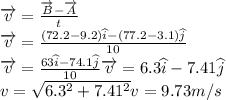
Physics, 14.05.2021 16:00 snikergrace
In a given cartesian coordinate system a particle is in the position (initial vector position) ( 9.2 , 3.1 ) meters. After 10 seconds, the particle is in the position (final vector position) ( 72.2, 77.2 ) meters. What is the magnitude of the average velocity of the particle during the given time interval, in m/s

Answers: 1
Another question on Physics

Physics, 22.06.2019 03:00
According to newtons universal law of gravitation, which would change the parh of the ball so it traces out widest curved path possible?
Answers: 1

Physics, 22.06.2019 09:50
Which statement correctly describes the current in a circuit that is made up of any two resistors connected in parallel with a battery? a. the current in the battery and in each resistor is the same b. the current the battery equals to the sum of the currents in the resistors c.the current in the battery is less than the current in either resistor d. the current in the battery equals to the product of the currents in the resistors
Answers: 1

Physics, 22.06.2019 11:50
Question 1 (5 pts): what is the maximum distance for which you can you resolve the two individual headlights of an on-coming truck as two separate lights rather than one if the headlights are separated by 2.00 m and your eye has a diameter of 1.00 centimeter? assume a wavelength of 500 nm.
Answers: 2

Physics, 22.06.2019 19:30
Amass m = 74 kg slides on a frictionless track that has a drop, followed by a loop-the-loop with radius r = 18.4 m and finally a flat straight section at the same height as the center of the loop (18.4 m off the ground). since the mass would not make it around the loop if released from the height of the top of the loop (do you know why? ) it must be released above the top of the loop-the-loop height. (assume the mass never leaves the smooth track at any point on its path.) 1. what is the minimum speed the block must have at the top of the loop to make it around the loop-the-loop without leaving the track? 2. what height above the ground must the mass begin to make it around the loop-the-loop? 3. if the mass has just enough speed to make it around the loop without leaving the track, what will its speed be at the bottom of the loop? 4. if the mass has just enough speed to make it around the loop without leaving the track, what is its speed at the final flat level (18.4 m off the ground)? 5. now a spring with spring constant k = 15600 n/m is used on the final flat surface to stop the mass. how far does the spring compress?
Answers: 3
You know the right answer?
In a given cartesian coordinate system a particle is in the position (initial vector position) ( 9.2...
Questions


Mathematics, 14.07.2019 07:30

Mathematics, 14.07.2019 07:30

Health, 14.07.2019 07:30





Mathematics, 14.07.2019 07:30



Mathematics, 14.07.2019 07:30

Mathematics, 14.07.2019 07:30


Mathematics, 14.07.2019 07:30

Physics, 14.07.2019 07:30

Mathematics, 14.07.2019 07:30

Mathematics, 14.07.2019 07:30

Health, 14.07.2019 07:30

Mathematics, 14.07.2019 07:30




